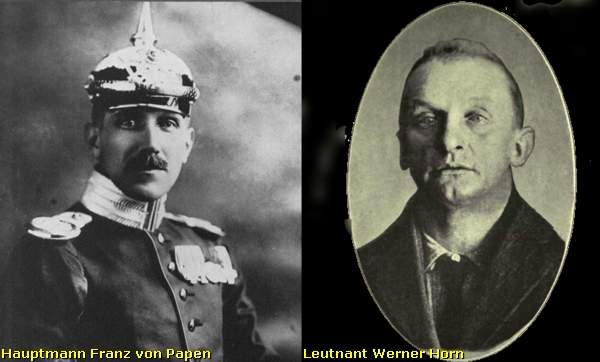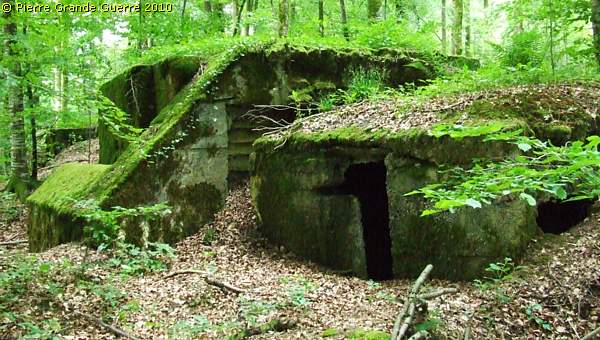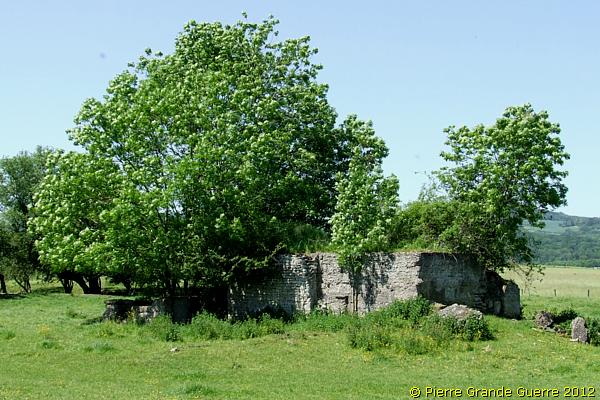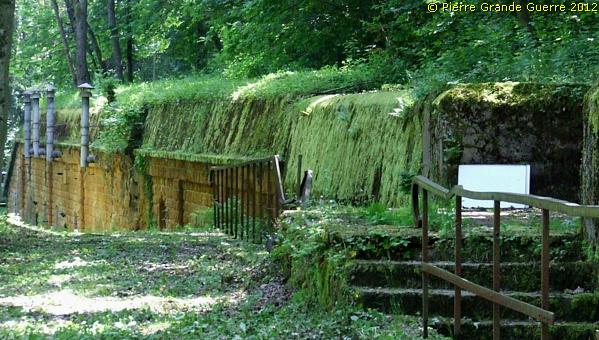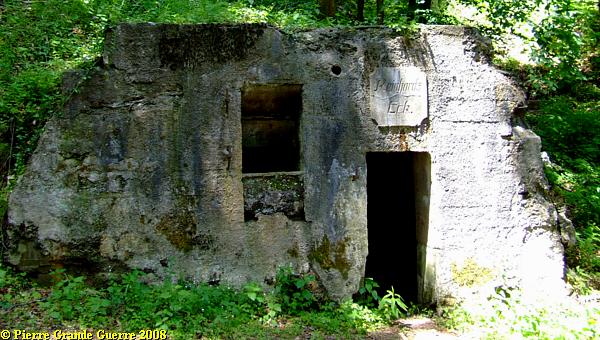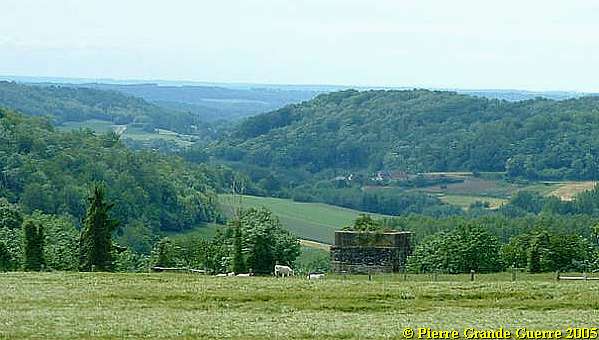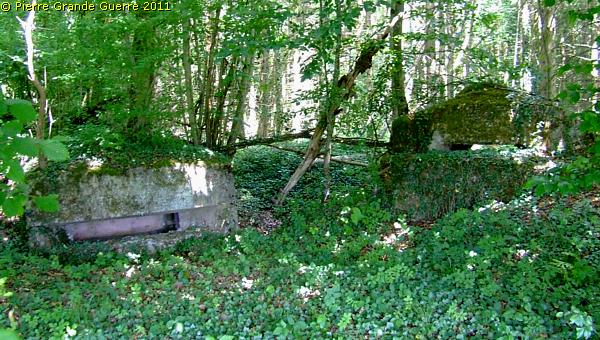VOSGES - Cols de la Chipotte - Chapelotte - Col du Donon
Year of visit: 2008 - 2010 - 2011 - 2012

On rainy days in June 2008 and 2010 we went from Senones to the west and later more to the north , to visit the passes of three important summits in the Northern Vosges . These formed the battlefields of the Battle of the Haute Meurthe - Mortange of August and September 1914. A photo report of a visit to the Col de la Chipotte , some 25 km. to the north , to Pierre- Percée and via Badonviller to the Col de la Chapelotte and its "Cave of the Poilus ", to cross next the front line near Allarmont , to continue in 2011 to the north-east , to the Col du Donon , and to finish some 8 km. eastward at the Nécropole Nationale de Wisches .
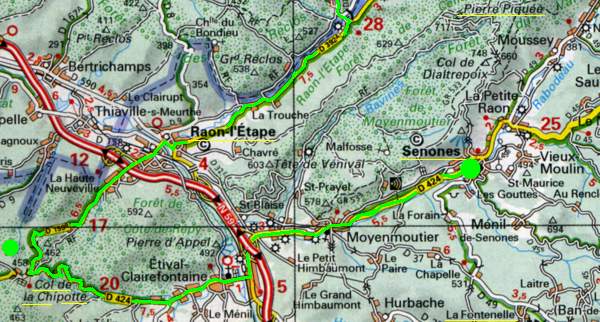
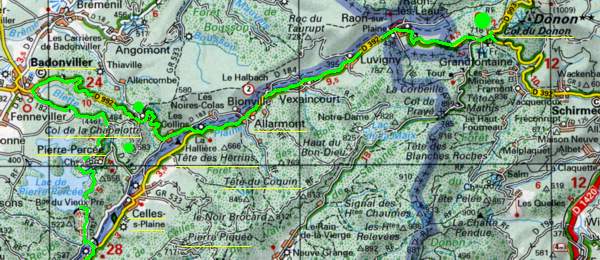
Col de la Chipotte (458 m.)
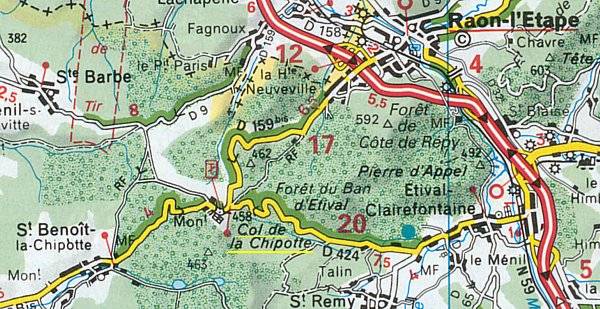
Northeast of Saint Dié des Vosges and southwest of Raon l' Etape along the D 424, lies the Pass of la Chipotte.
At the northern side of the road stands this memorial to commemorate:

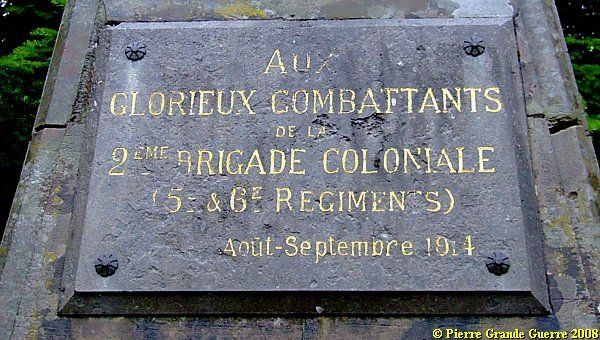
Colonel Jean-Baptiste Marchand (1863-1934)
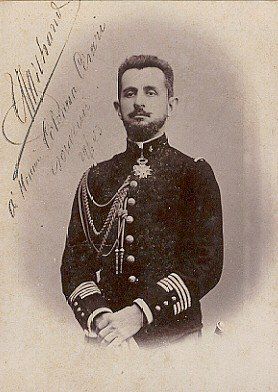
Marchand was a famous French military explorer , involved in the African Fashoda-Incident of 1898 in what is now Sudan, being a Major in command of 150 French Colonial riflemen . Later on, during his career in the Great War, Marchand even became a General on 20 February 1915.
In September 1914 Jean-Baptiste Marchand commanded the 2me Brigade Coloniale , still being a Colonel . Colonel Marchand was wounded on the slopes of la Chipotte on 1 October 1914 by the impact of a shell.
On the
rear
side of the
memorial, another
plaque:
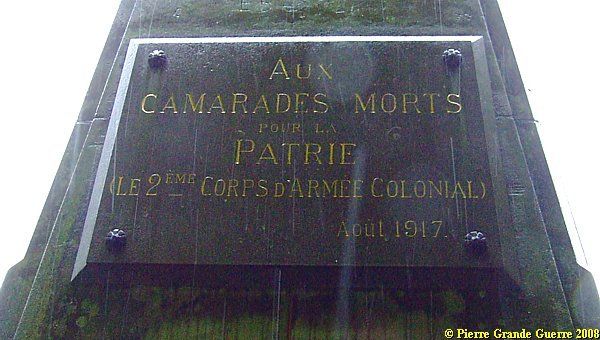
The Battle of the Haute Meurthe - Mortagne (25 August - 11 September 1914)
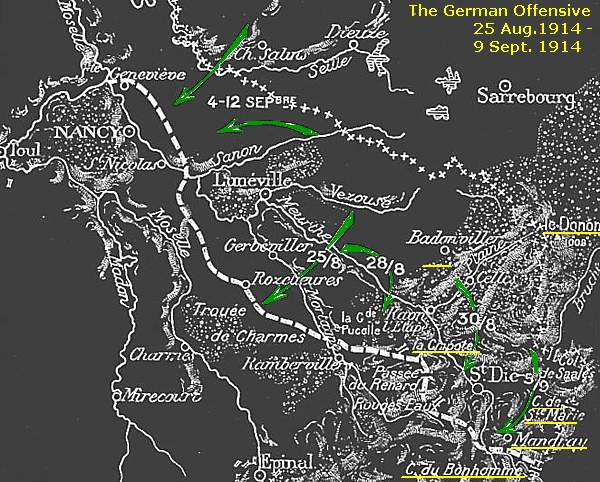
1. The front around Nancy: Castelnau versus Rupprecht von Bayern
After the first successes of the French 1st and 2nd Army in Alsace Lorraine, the Germans decided to counterattack the two French Armies. On 20 August 1914 Crown Prince Rupprecht von Bayern's 6th Army attacked General Castelnau's 2nd Army. From Morhange and Dieuze the Bavarian Army attacked Nancy, Dombasles, and Lunéville. Between 21 and 23 August the Second Army of General Castelnau was forced to retreat to the Grand Couronné near Nancy and to the valleys of the Mortagne and the Meurthe.
On 24 August the Bavarian 6th Army was also advancing to a gap in the French front, a front line without fortresses around Charmes, called the "Trouée des Charmes". This was also the sector where the French 2nd Army linked up with the General Dubail's 1st Army. During the Battle for the Trouée des Charmes from 24 until 26 August 1914, it took the French 2nd Army much effort to withstand these German attacks.

2. Three cols in the Northern Vosges: The Battle of the Haute Meurthe - Mortagne
Also on 24 August General von Heeringen's 7th Army launched, south of the Trouée des Charmes, the Battle of the Haute Meurthe - Mortange, at three mountain passes in the Northern Vosges, on the left flank of General Dubail's 1st Army. These passes were important roads to the west for the advancing Germans. Von Heeringen's plan was to conquer Saint Dié des Vosges.
General von Heeringen's 7th Army attacked on 24 August successfully the pass of the Col du Donon. On the 26th the Germans attacked the Col de la Chapelotte. The French were forced to withdraw. Between 24 August and 5 September the Germans tried to conquer the Col de la Chipotte. The French forced them back to the eastern slopes of the Col de la Chapelotte about 9 September, assisted by the retreat of von Heeringen to the new front line, west of Saales. This front line, symbolised on the coloured map below with a closed red line, would stay in a "stalemate"-situation from 1915 until 1918.
3. German retreat around Nancy
In the meantime the Battle for the Grand Couronné, which started at 31 August, was not successful at all for the German 6th Army. At 11 September the Germans decided to withdraw the 6th Army. Under pressure of General's Foch's 20th Army Corps the Germans retreated from Nancy to behind the German border of 1871-1918.
(Read for more details of this Lorraine battle my near future Photo Impression; "The Gap of Charmes").
Some military historians comment that the results of the Battles of the Grand Couronné and of the Battle of the Haute Meurthe - Mortange were of great importance, and that these battles had a decisive influence on the results of the Battle of the Marne of 5 - 10 September 1914.
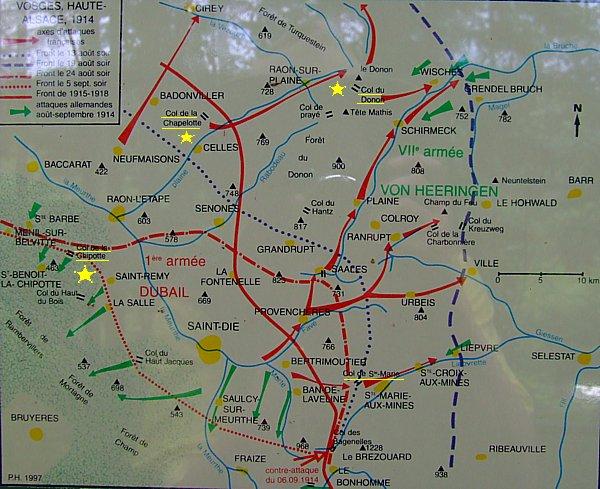
At the southern side of the junction at the Col de la Chipotte , stands this memorial, a Poilu in front of a jetty, symbolising the stubborn resistance of the 86th Light Infantry Brigade or 86e Brigade Chasseurs à Pied.


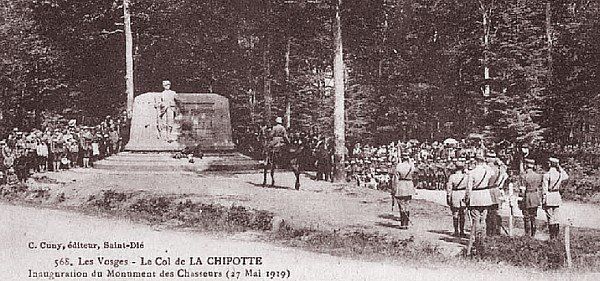
Notice the Chasseur à Pied in a 1914 style battledress.
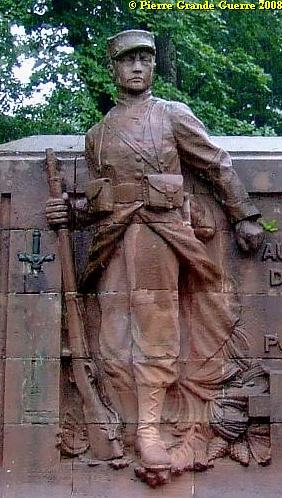
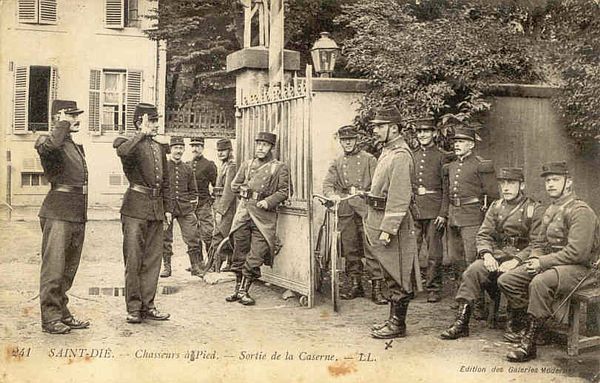
At the right hand of the Chasseur à Pied lies the French Nécropole Nationale de La Chipotte .

The La Chipotte National Cemetery contains the graves of 1,899 soldiers. 893 Of these soldiers are buried in 2 ossuairies.
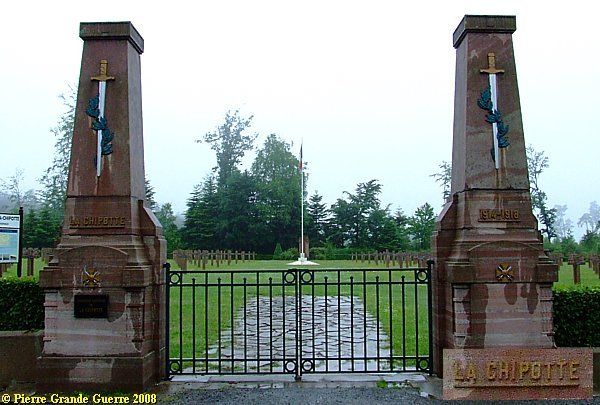
The cemetery contains the graves of Chasseurs à Pied , soldiers of Colonial Infantry Regiments, Engineers, and soldiers of (Territorial) Infantry Regiments, who died in this front sector of la Chipotte.
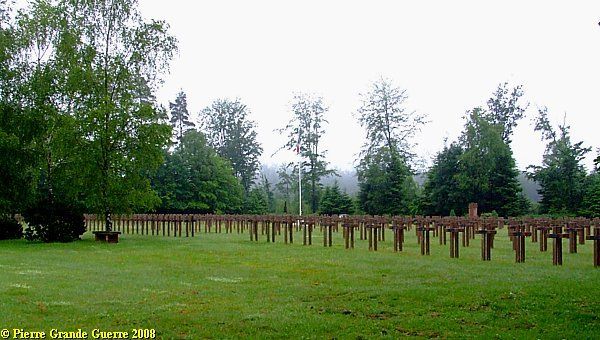
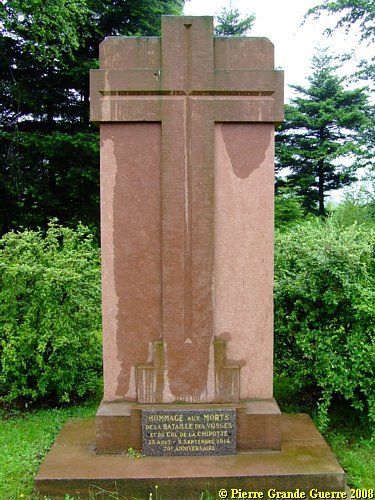
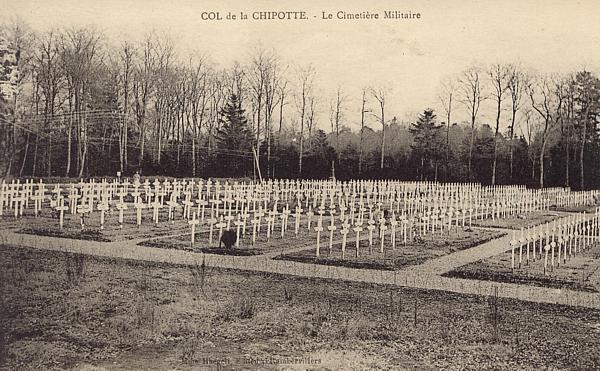
At the end of the cemetery are two ossuaries.

The ossuary on the right contains the mortal remains of 349 unknown soldiers, and 3 known soldiers.
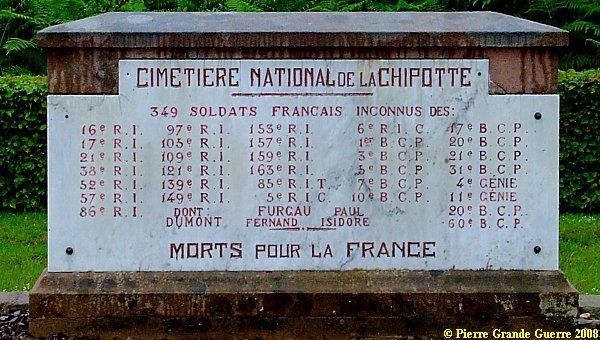
The ossuary on the left contains the relics of 542 unknown soldiers, and 11 known soldiers.
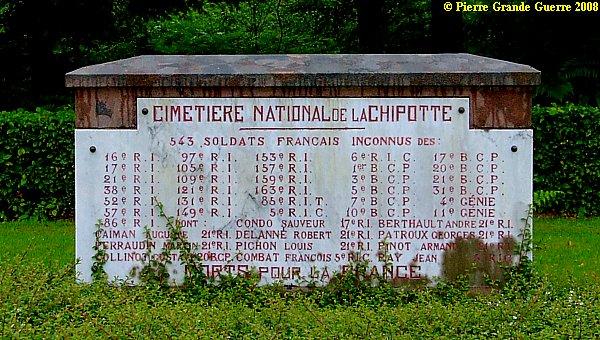
The French soldiers called la Chipotte "Le Trou de l ' Enfer ", the Hell Hole.
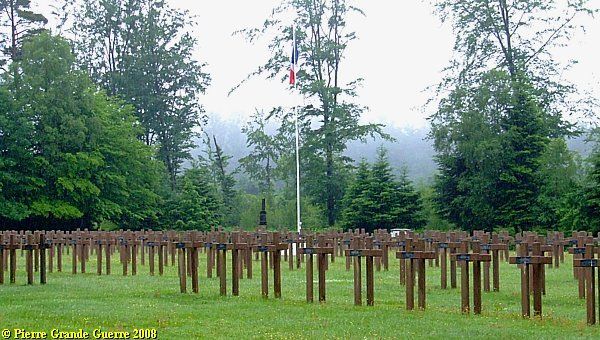
At the end of the cemetery , in the left corner, stands a memorial in the shape of a broken column, ...
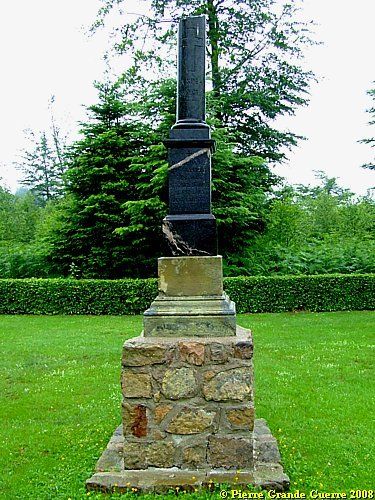
... in honour of the light infantry battalions , the "Bataillons Chasseurs", and the infantry regiments, which fought here on the slopes of la Chipotte.
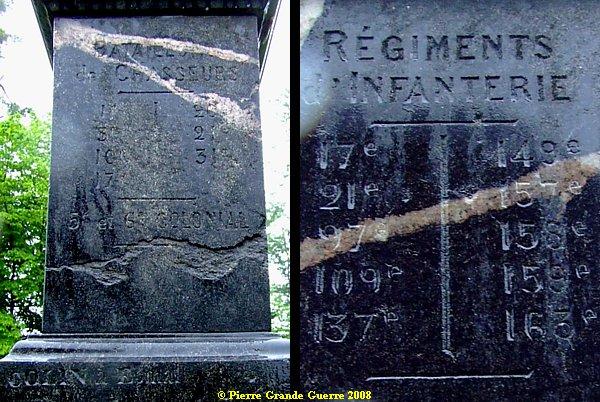

With a last view over the cemetery we depart for the Col de la Chapelotte.
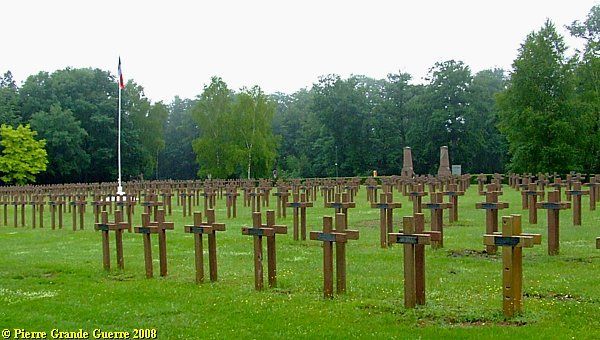
We continue our route northward to Pierre Percée , ...
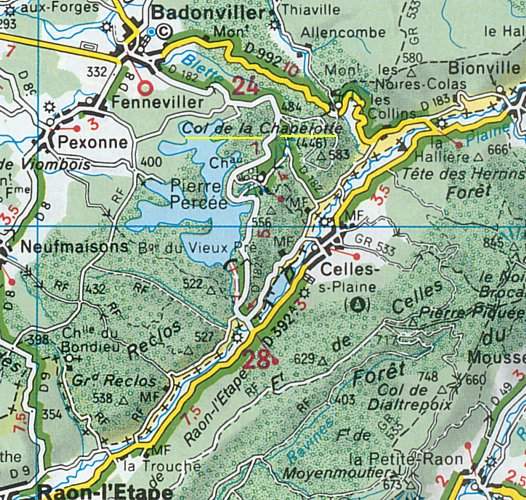
... where we find this Poilu statue of a Chasseur Alpin.
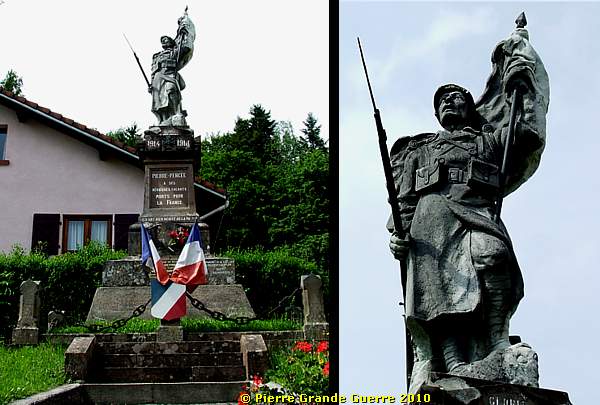
Some 500 m. more westward we arrive at the 363e R.I. Memorial.

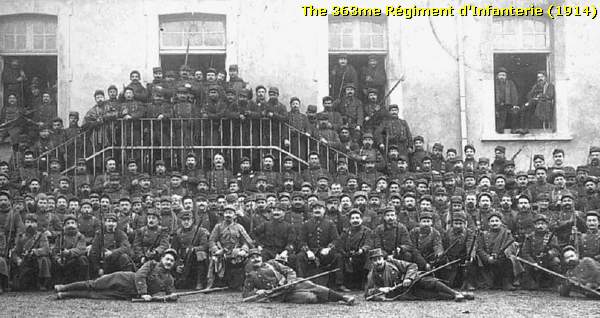
The sculptor , Antoine Sartorio (1885-1988), ...
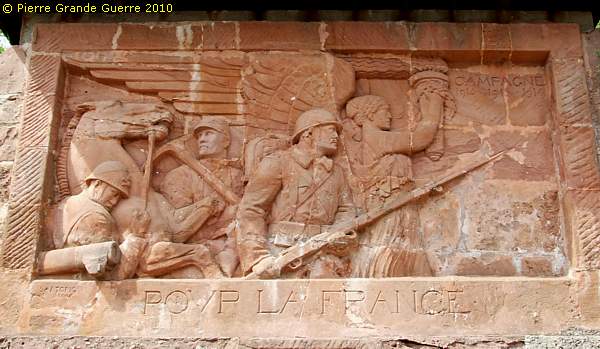
... who fought as a soldier of the 363e R.I. in the Vosges , ...
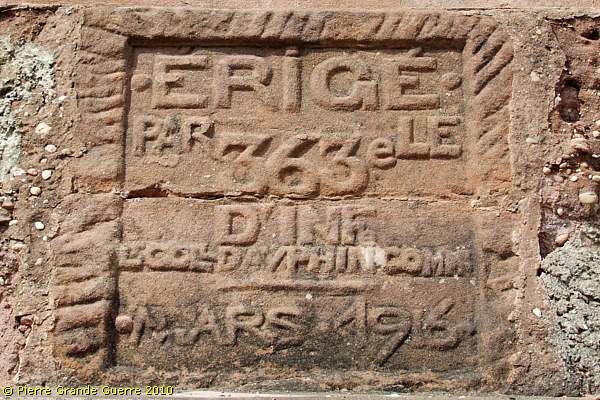
... designed this March 1916 memorial, inaugurated by Lt. Col. Dauphin.
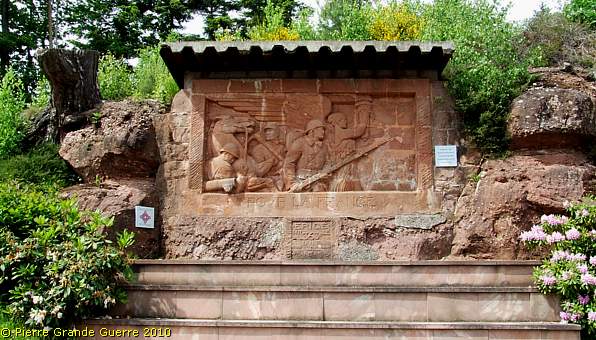
I turn my back to the memorial to see this panorama.

The 363e R.I. Memorial offers this panoramic view south-eastward to the former front lines on the mountain ridge. The summits in this sector, the Tête du Gros Colas , the Tête de Cocquin , the Pain de Sucre, and the Pierre Piquée , were all occupied by the Germans. The French were positioned on the lower west slopes. I show you this panorama in two steps.

From left...
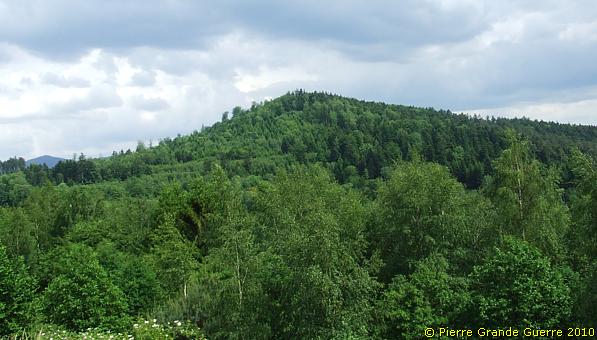
... to right.
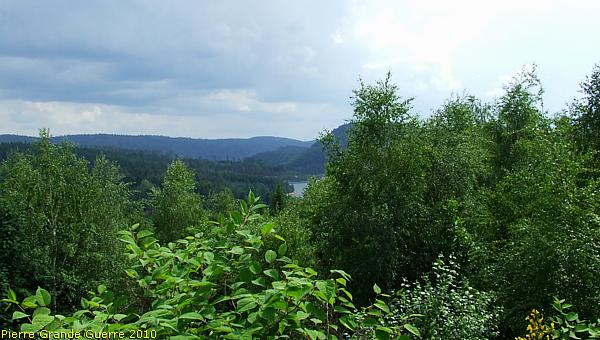
From Pierre Percée we continue to Badonviller.
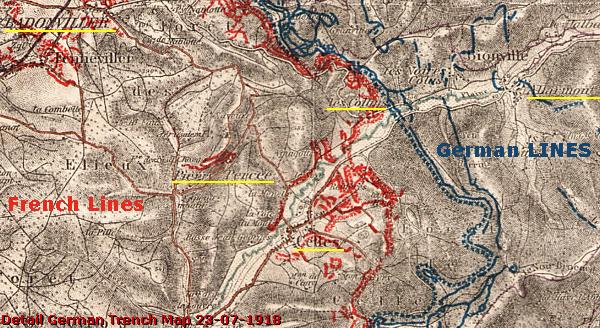
At the northern outskirts of Badonviller we find...
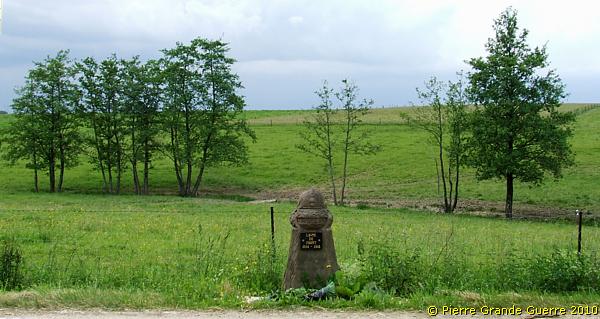
... this after -war demarcation stone , presenting the most forward advance of the Germans, north of Badonviller.

Col de la Chapelotte (447 m.)
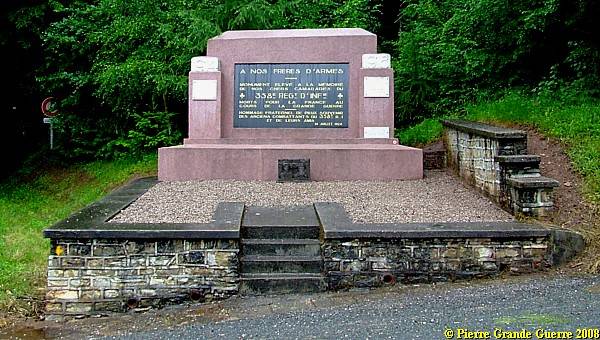
From the eastern edge of the village of Badonviller we approach the Col de la Chapelotte, along the D 992, to find this memorial, on the northern side of the road.
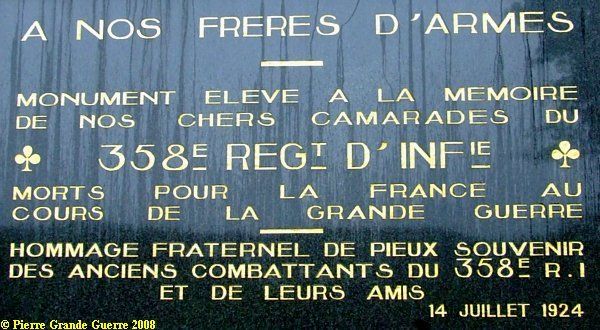
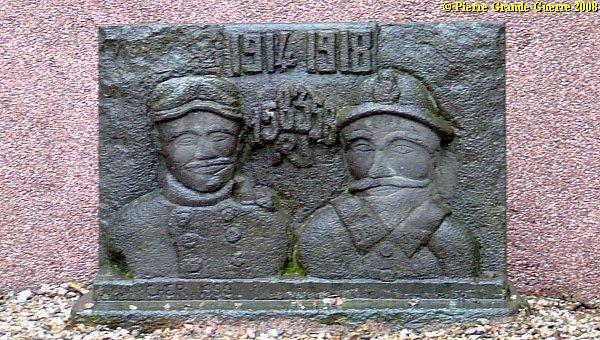
On the col, along the south side of the road , we find this demarcation stone, symbolising the most forward advance of the Germans in this front sector.
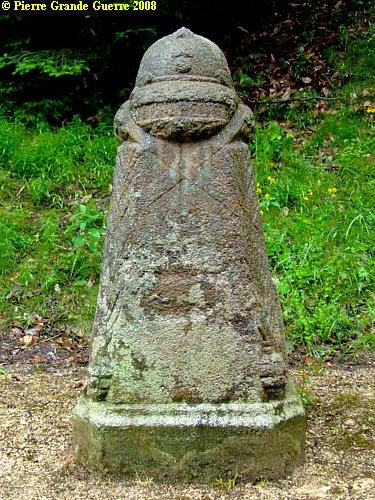
On the north side of the col is another memorial:

The memorial is located in front of this former gateway to the Chapel grounds.

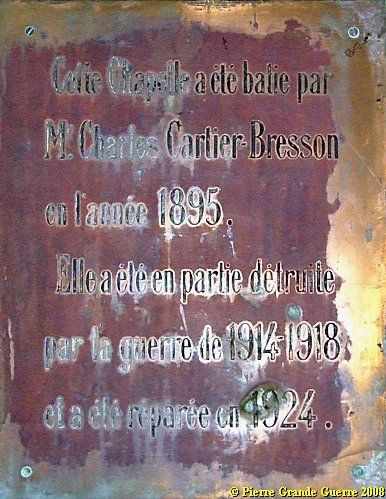
Mr. Cartier-Bresson (Paris, 1852 - Nancy, 1921) was an industrialist and Mayor of nearby Celles-sur-Plaine, who received during the war the Croix de Guerre and the Légion d'Honneur for his attitude (i.e., closing down his cotton factories in occupied Celles-sur-Plaine from August 1914 until 1918.) He was the father of Henri Cartier-Bresson , the founding father of modern photojournalism.
A view of the
interior
of the
Chapel.

We cross the road again , to the southern side, to find some relics of a trench behind the demarcation stone.
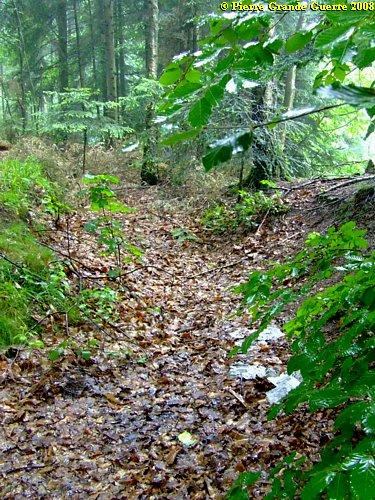
Two army situation sketches of the period.
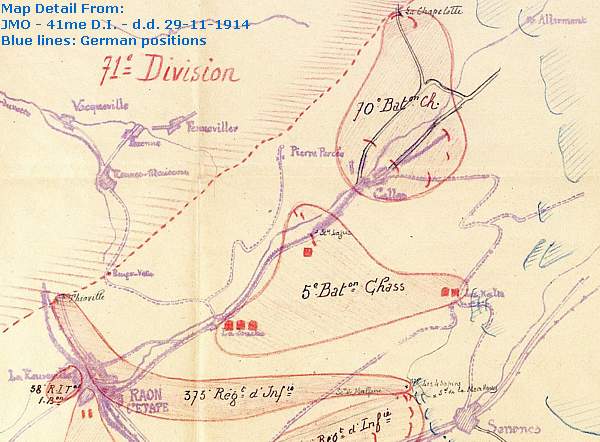
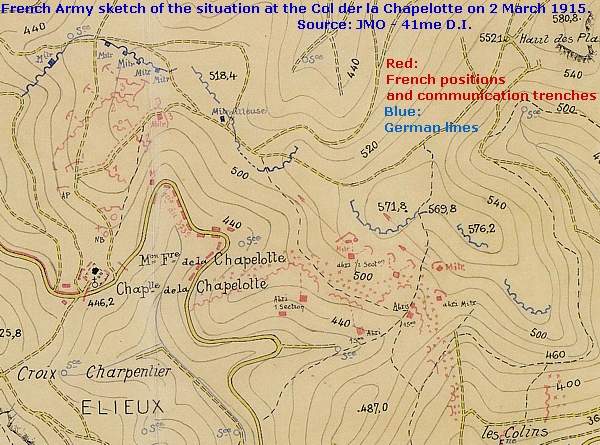
Some 50 m. away from the D 992 we find this water fountain.

The fountain has been built during the war by the 338e Infantry Regiment "Pionniers", engineers.
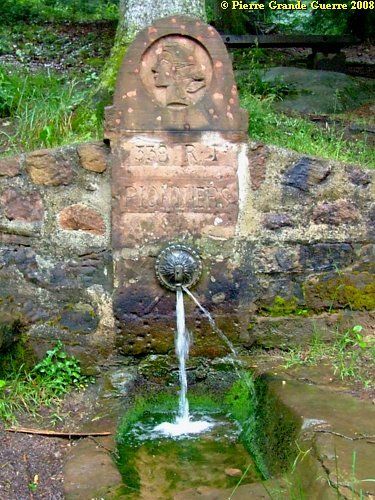
From here leads a path , the GR 533, the " Sentier des Roches ", or the Path of the Rocks southward to La Grotte des Poilus.
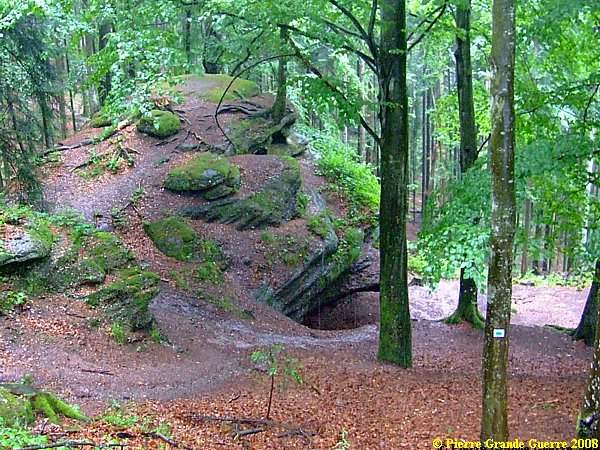
The distance to the rock and the cave is about 1.2 km.
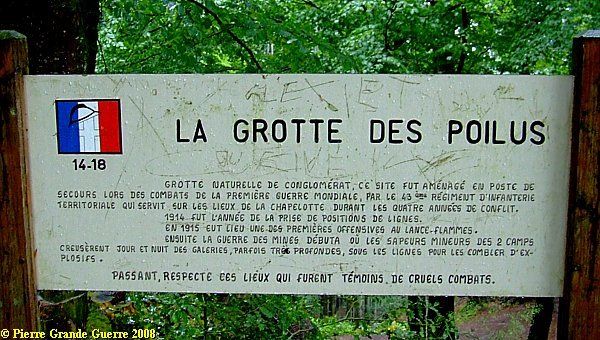
" THE CAVE OF THE POILUS
BEING A NATURAL COMPOUND CAVE, THIS SITE WAS EXPLOITED AS A DRESSING STATION DURING THE BATTLES OF THE FIRST WORLD WAR BY THE 43th TERRITORIAL INFANTRY REGIMENT ( from Epinal ), WHICH SERVED IN THIS AREA OF LA CHAPELOTTE DURING THE FOUR YEARS OF THIS CONFLICT.
1914 FORMED THE YEAR OF TAKING POSITIONS IN THE LINES.
IN 1915 IT FORMED THE AREA OF THE FIRST OFFENSIVES WITH USE OF FLAMETHROWERS.
NEXT THE MINE WARFARE STARTED, WHERE SAPPERS AND TUNNELERS OF 2 SIDES DUG CORRIDORS DAY AND NIGHT, SOMETIMES VERY DEEP, UNDER THE LINES TO FILL THESE TUNNELS WITH EXPLOSIVES.
PASSER-BY, RESPECT THIS AREA, WHICH WITNESSED CRUEL FIGHTS."
This rock near the entrance of the cave served as a shelter. The 43me R.I.T. has even constructed a support for the rock.
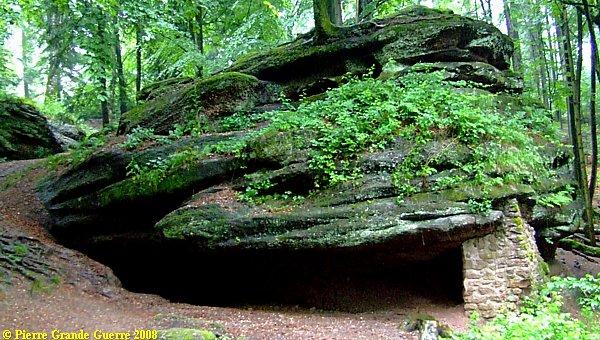
The entrance to the cave , seen from below the rock.
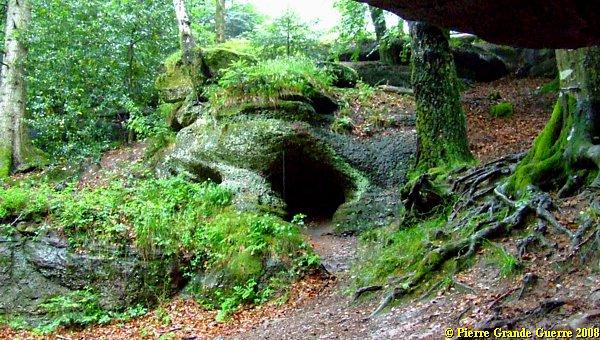
I walk around the huge rock to find another shelter under it.



It looks to have been a carved out water fountain.
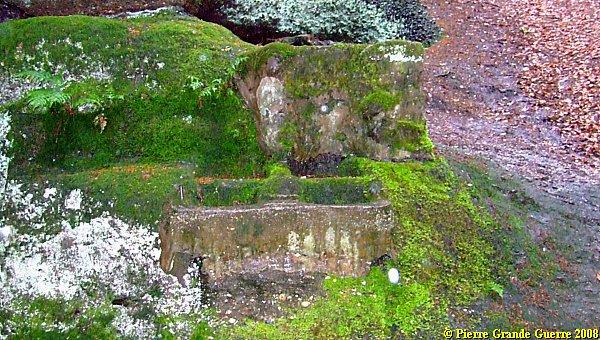
We leave the rock and the cave.
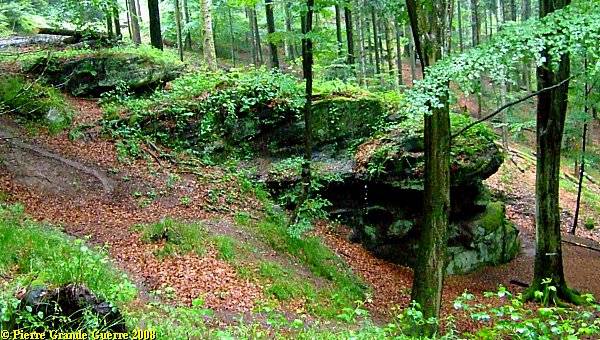
From the Grotte des Poilus we return to the Col de Chapelotte.
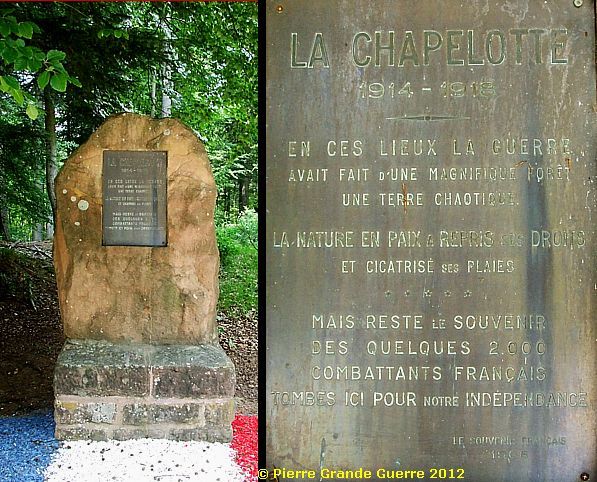
In 2012 we returned to the Col. This time we enter the wood on the northern side of the Col behind this memorial.
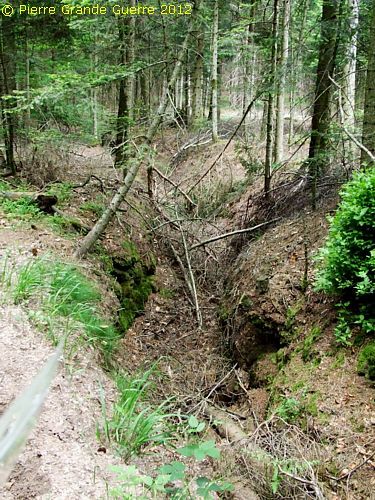
Following a path upward and northward ….

…. we enter the front line finding traces of trenches and bunkers.
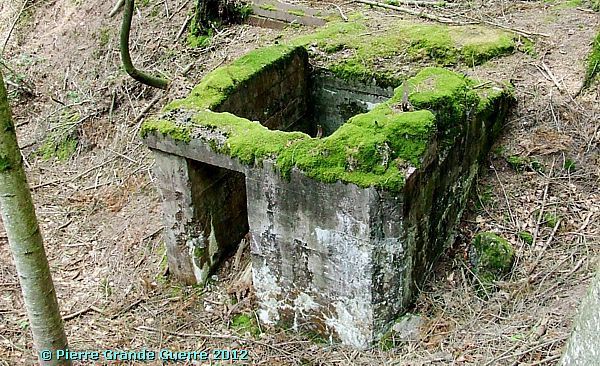
Just when we are able to detect more bunkers, ….
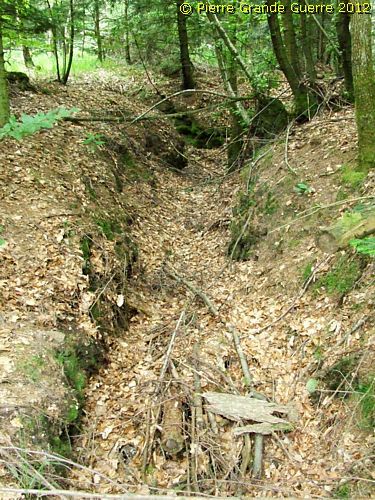
… a unexpected thunderstorm suprises us.

For security reasons we are forced to abort this mission, alas!
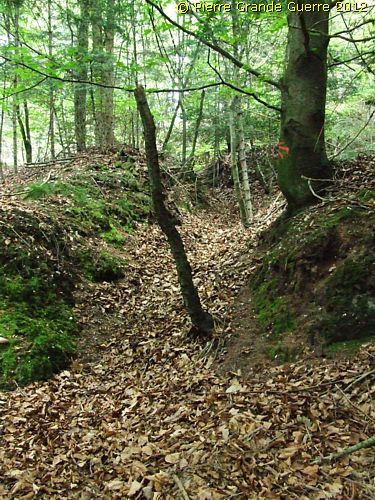
In haste we return to the Col de la Chapelotte and from there we continue the route of our trips of 2010 and 2011 to Allarmont , ...
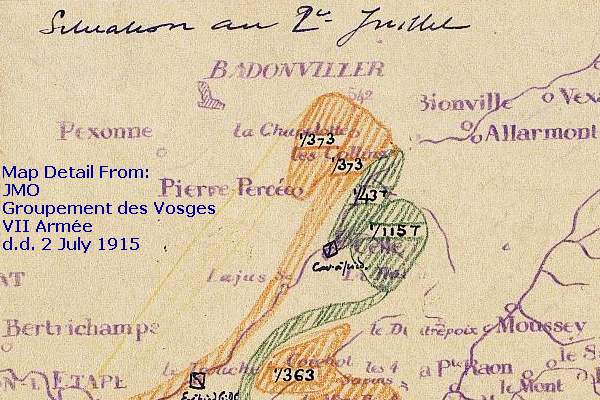
... on the German side of the frontline.
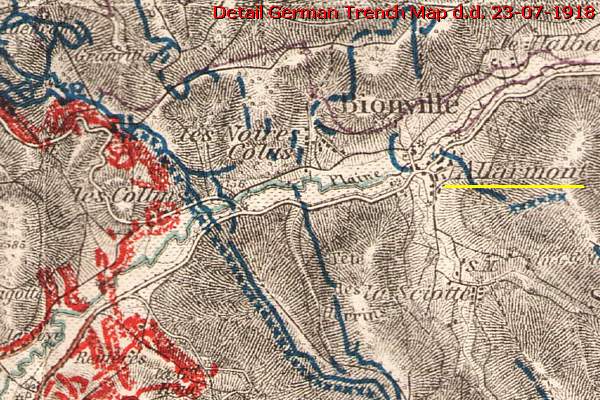
Along the D 392, just before the village , stands a concrete witness of the German presence.
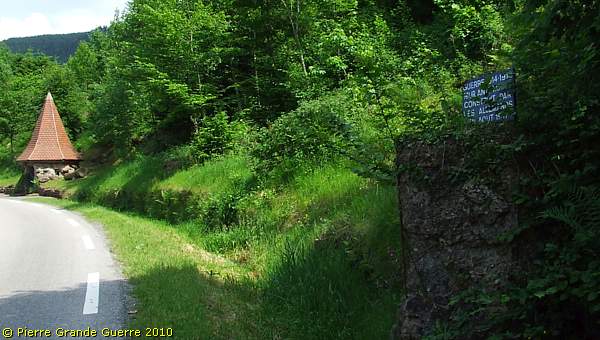
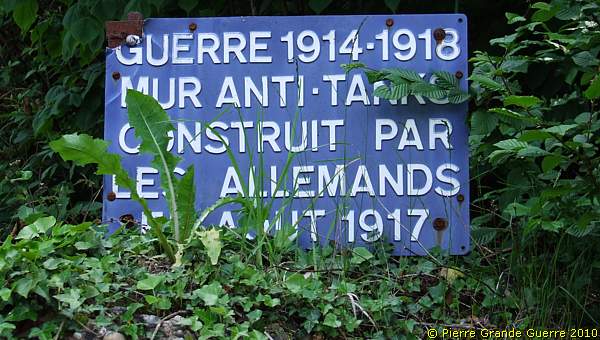
The relics of a concrete anti-tank wall , constructed by the Germans, guard the village.
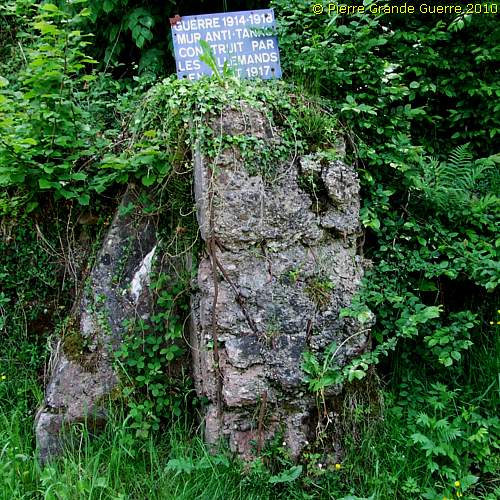
Behind the village church of Allarmont , ...
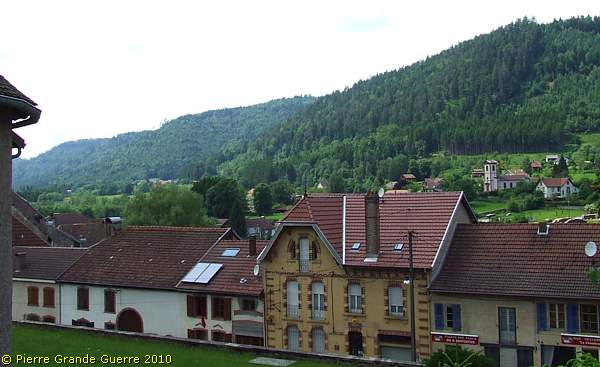
... we find another silent witness of the German presence in the village.
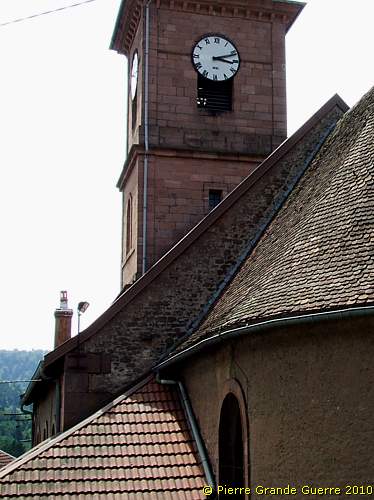
The headstone for two soldiers , fallen in the spring of 1915; A soldier of the Ersatz-Bataillon 99, and a medic.

From Allarmont we depart to the Col du Donon. We are now in the 1915-1918 front sector of the Bavarian "Donon Brigade".
The
Bavarian
"
Donon
Brigade"
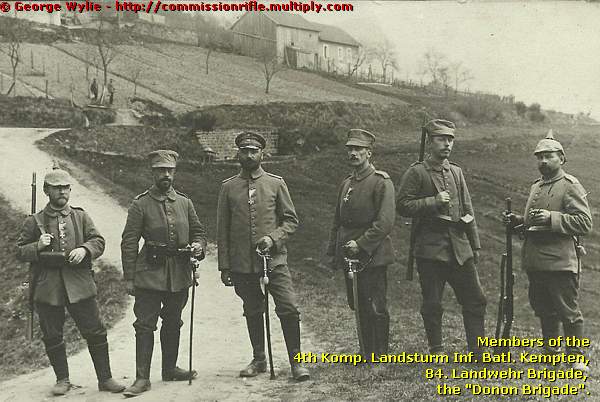
| The 84 Landwehr Brigade was deployed in Alsace . The brigade was originally the ' acting ' 84 Infantrie Brigade, renamed Brigade Neuber September 1914, and again renamed 84 Landwehr Infantrie Brigade on January 1915 in the Donon ( Vosges ) sector. Again re- designated Donon Brigade until April 1915, and re- designated Sector Plaine 1915-18. It was last re- designated Sector Mailly from April 1918. The men in the period photo are Bavarian Landsturm members of the 4th Komp . Landsturm Inf. Batl . Kempten , 84. Landwehr Brigade, photographed on 13 Mai 1915. The event appears to be a commemoration of awards received . The officer third from left wearing the M1910 schirmmutze appears to have been awarded the Bavarian Militärverdienstkreuz 1. klasse mit schwertern . Military Merit Cross 1st Class with swords . The enlisted man at far left is decorated with the Bavarian Militärverdienstkreuz 3. klasse mit schwertern . Military Merit Cross 3rd Class with swords . Awards with swords were authorized to distinguish wartime awards in 1891. The Lance Corporal third from right is decorated with the Bavarian Militärverdienstkreuz 3. klasse mit schwertern and crown . The crown could be used for a second award to an NCO or soldier who had been previously been awarded the medal and whose rank precluded award of a higher class, or to recognize greater merit . The Bavarian Militärverdienstkreuz became Bavaria's main decoration for bravery and merit by enlisted soldiers in World War I, roughly equivalent to Prussia's Iron Cross, which became the general gallantry award of the Geman Empire. Information: Courtesy of George Wylie, U.S.A. - Period photos in this frame: Courtesy of George Wylie, U.S.A. and Sam Wouters, Belgium. |
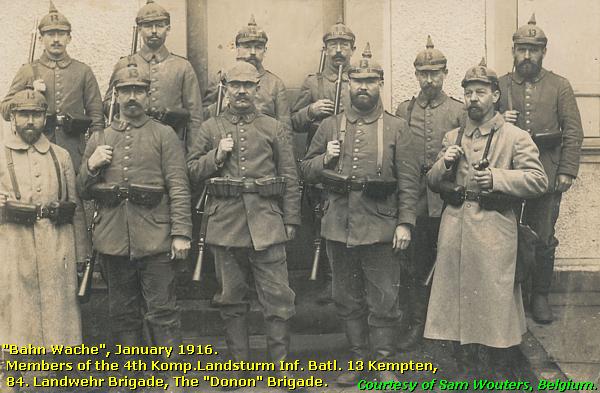
The Col du Donon (718 m.)
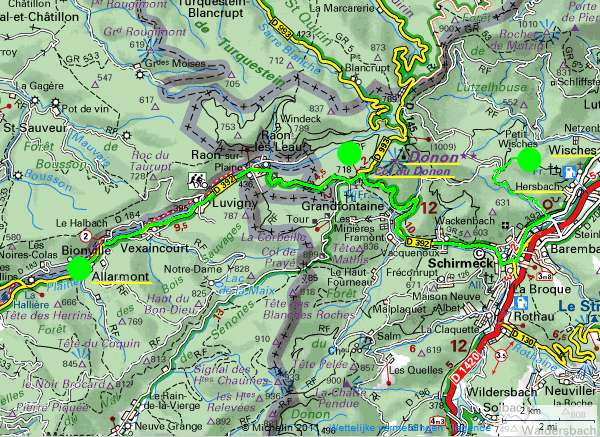
We continue along the D 992, and turn left on the D 392 to approach the Col du Donon from the west.


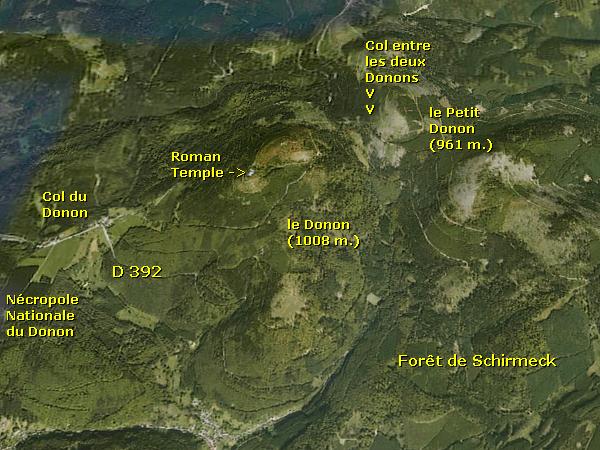
From the west of the Col the first view of the Donon mountain (1.008 m.).
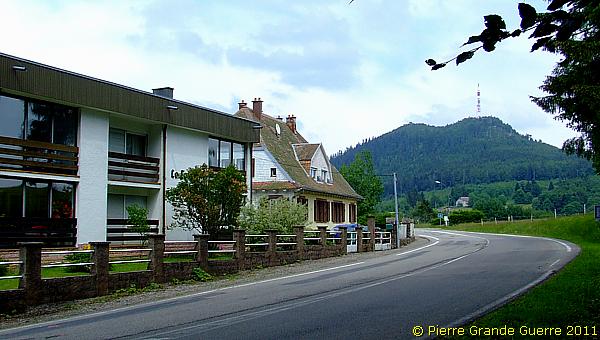
An even better view of the Donon.
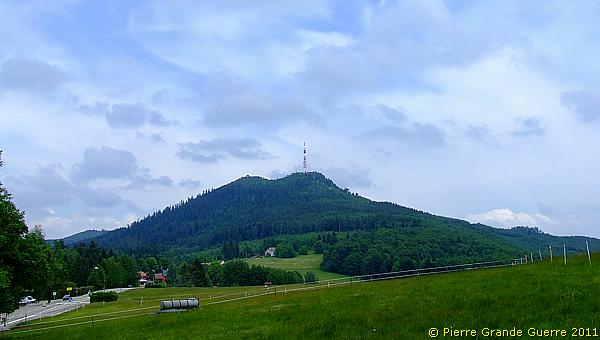
Teleview of the summit of the Donon. The view of the original Roman Temple (!) on the left has been wasted by this ugly modern communications tower.
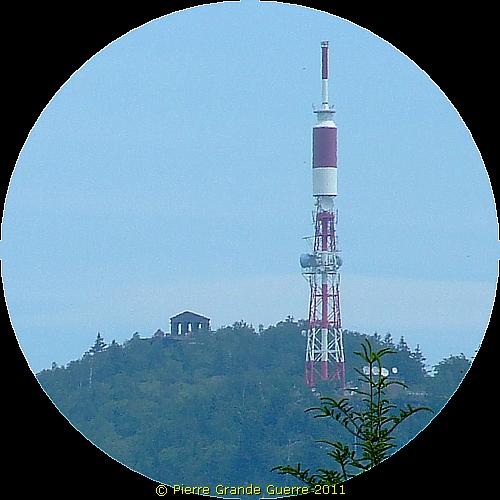
At the southern side of the pass lies the Nécropole Nationale du Donon , which we visited in 2008.
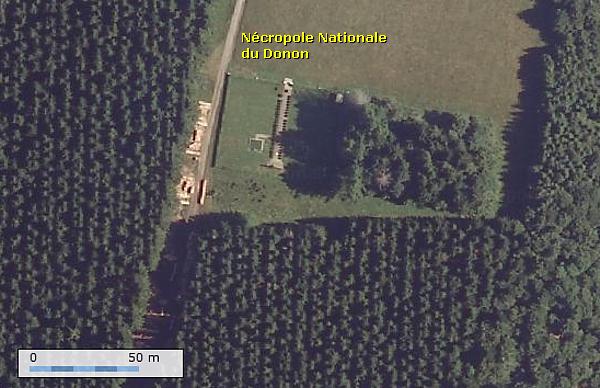
The National Cemetery of the Donon contains the human remains of 324 soldiers. 182 Of these soldiers are buried in 2 ossuaires.
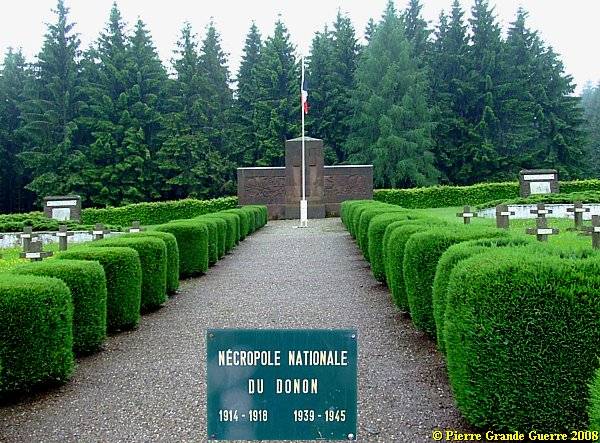
The memorial possesses some interesting bas- reliefs.
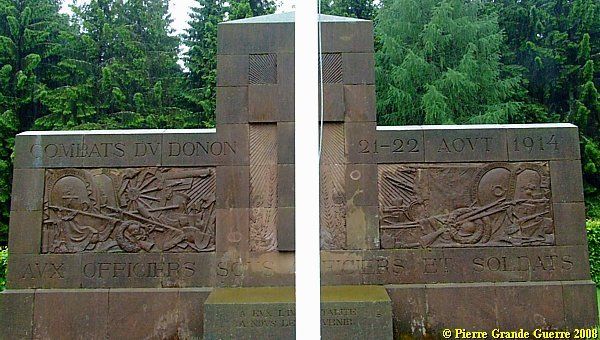
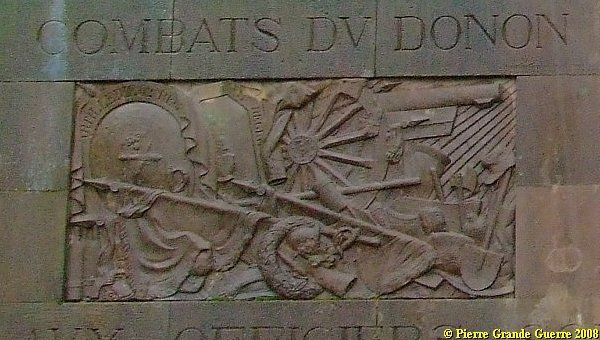

As often , also this cemetery possesses two Ossuaries.
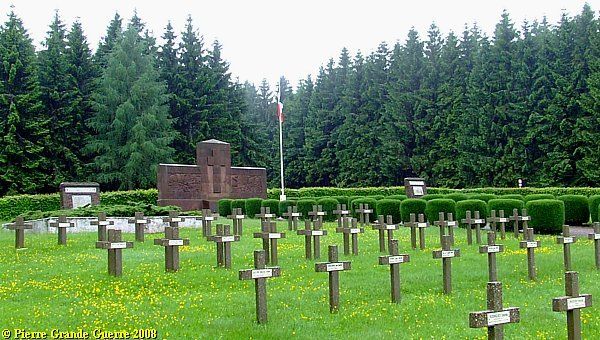
The ossuary on the left side of the memorial contains the relics of 110 unknown soldiers of the 17e, 20e and 21e Bataillons Chasseurs à Pied.

The ossuary on the right contains the mortal remains of 71 unknown soldiers of the 17e, 21e, 110e Infantry Regiments, and the 11e Regiment Engineers.
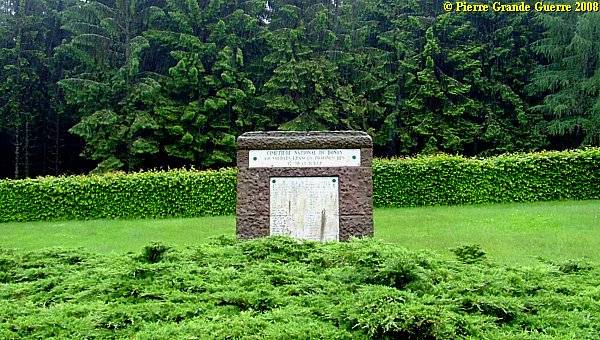
About 2 o'clock it started to rain cats and dogs.
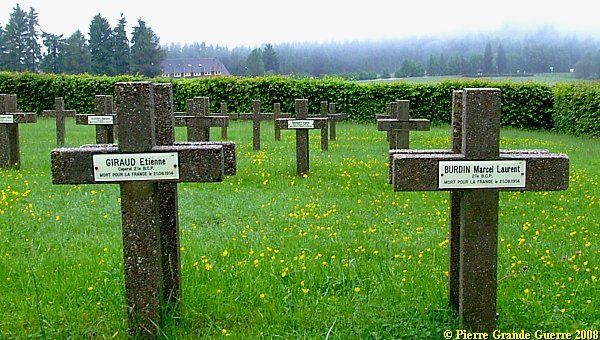
Thick , grey clouds would soon cover the mountain landscape and the Col du Donon in a thick fog. Alas we were forced to abandon our explorations for this day in 2008.

But whenever we are in the Vosges , we visit again the Donon. In 2011 the Donon formed our point of departure for our visit to the Nécropole Nationale de Wisches.

Following the D 392 we drive via Schirmeck eastward to Hersbach. Before we reach Wisches , we go left in the village of Hersbach , following a steep and winding forest road upward, the "Route du Cimetière Militaire ".
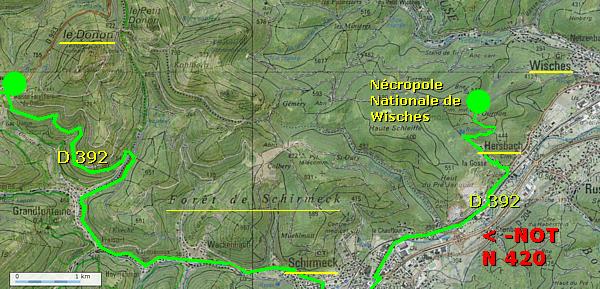
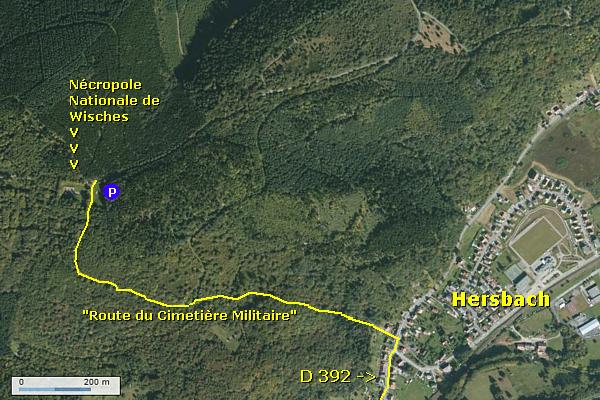
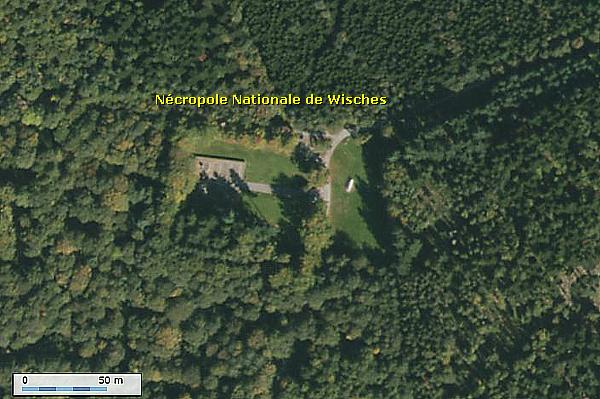
Almost hidden in the Schirmeck forest, west of Hersbach and Wisches lies this extraordinary Nécropole Nationale de Wisches .
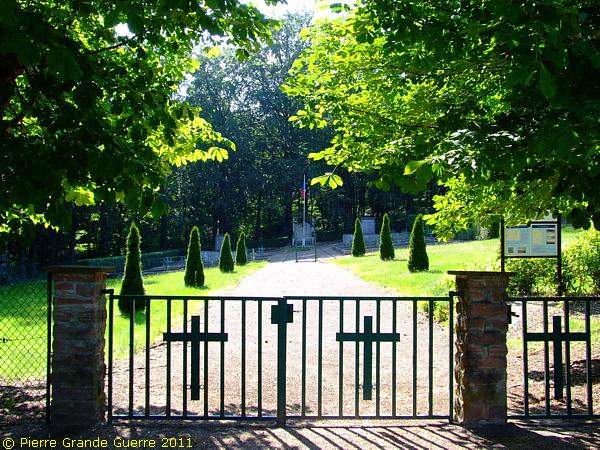
The Nécropole Nationale de Wisches contains the human remains of 504 soldiers. 444 Of these soldiers are buried in 2 ossuaires. The other men are buried in 60 individual graves. Most men buried here are victims of the combats at the Donon of 19-24 August 1914.

This military cemetery is extraordinary for its remarkable headstones, ...
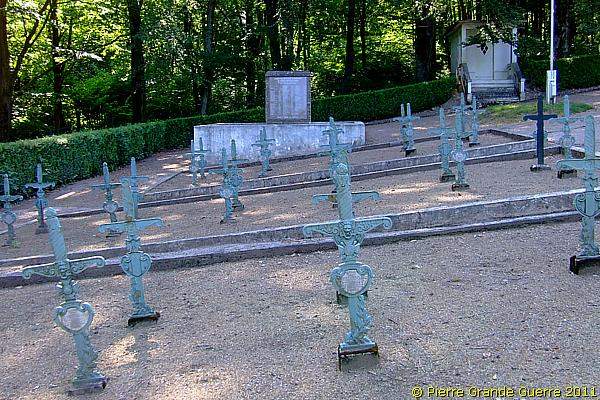
... which I only have seen once elsewhere along the front, to honour civilian war victims.
(See my near future photo impression about Gerbéviller , the Gap of Charmes , Lorraine.)

The headstones are in the shape of a sword in blue horizon, decorated with a lion's head and a laurel branch of honour at the foot.
The image once apparent in the Cross of Merit ( right photo ) of the symbol of France, “Marianne”, has been lost by weathering over time, alas.

" Le Souvenir Français ", "The French Remembrance ", is an official French, and also a private, association, which since 1887 has been responsible for creating and maintaining the majority of the war memorials in France.
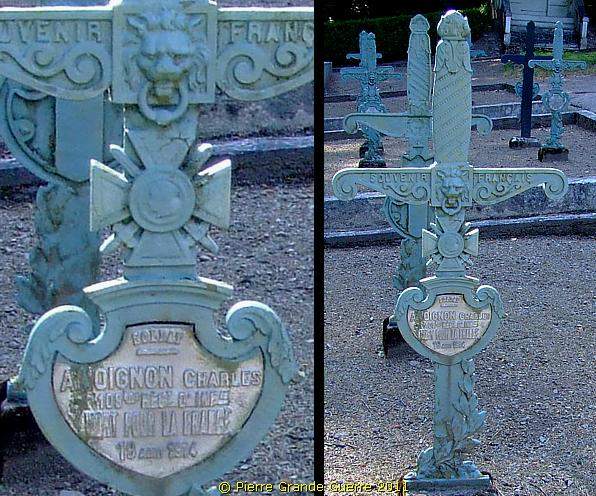
The cemetery possesses also two Ossuaries.
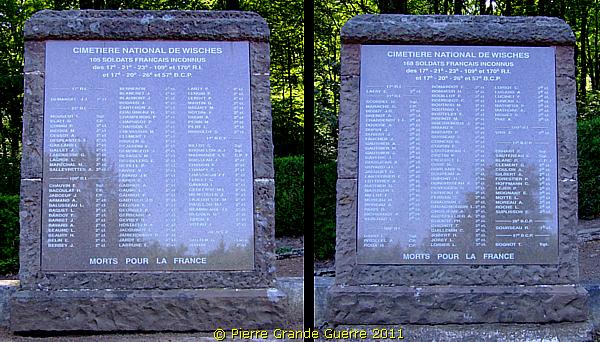
The southern ossuary (left) contains the human remains of: "105 UNKNOWN FRENCH SOLDIERS OF THE 17e -21e - 23e - 109e - 170e R.I. and 17e- 20e - 26e - 57e B.C.P."
The northern ossuary contains the human remains of: "168 UNKNOWN FRENCH SOLDIERS OF THE 17e -21e - 23e - 109e - 170e R.I. and 17e - 20e - 26e - 57e B.C.P."

Most men buried here are victims of the combats at the Donon of 19-24 August 1914.
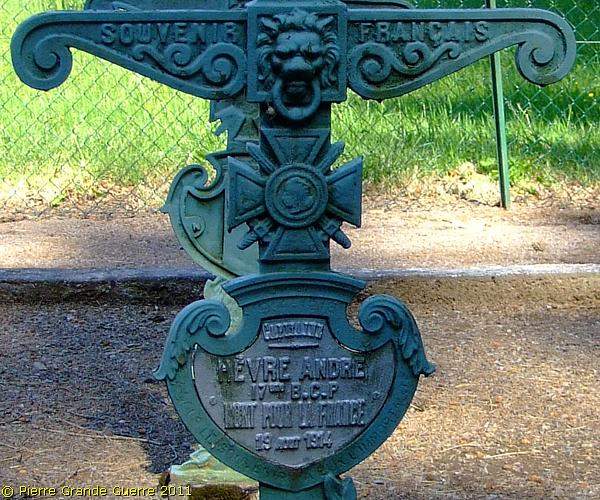
In the orange light of the late afternoon sun the blue horizon paint changes almost into a greenish colour.
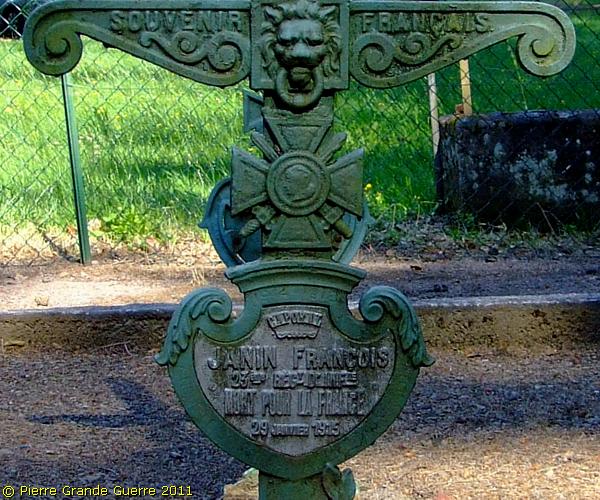
There is a hardly a “ sword ” to be found in this cemetery , ...

... which is still standing correctly upright.
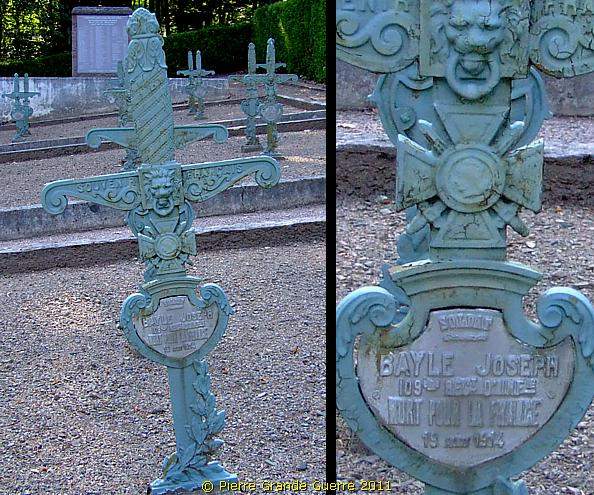
When sunset starts, we take our last view, ...
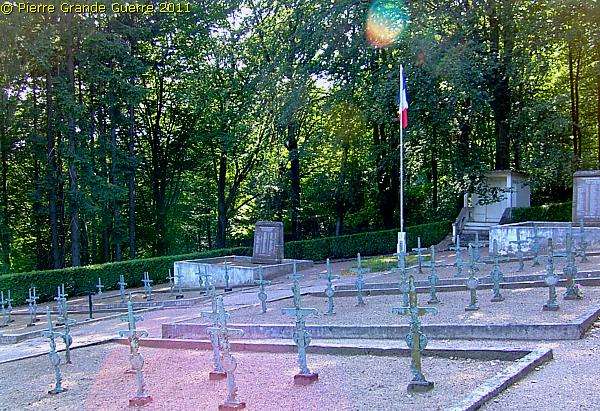
... and we leave the military cemetery of Wisches.

On the next page we will return to the Donon and we will continue with a visit to the many trenches, German bunkers and other concrete relics at the foot of the Donon.
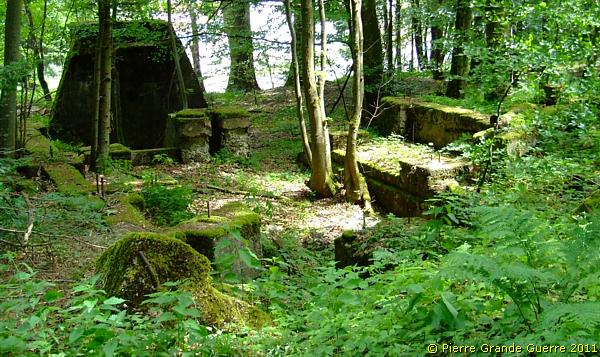
Continue to the next chapter : " The Donon - Bunkers and Trenches "
